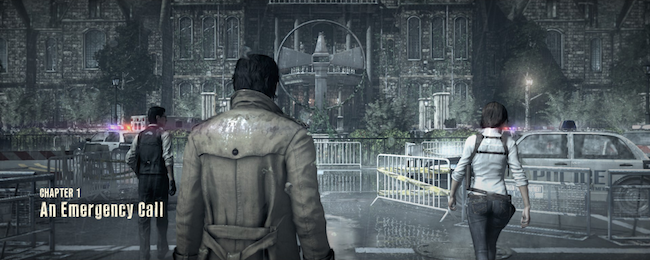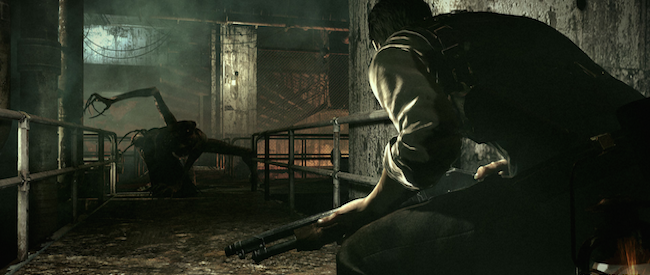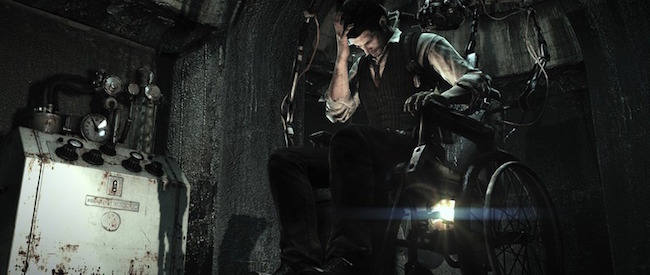
The Evil Within is a game I’ve been looking forward to for a long time. In fact, I even named it as my most anticipated game of 2014 in an article we published earlier this year. Survival Horror is my favourite genre in gaming – especially the Japanese variety, if I had to be more specific about it. Having grown up with Resident Evil and Silent Hill as the main staples of the genre, I’ve gradually had my heart broken as I’ve watched these big franchises struggle with their identity in recent years. Equally so as other great series such as Dead Space went the way of mediocre action.
Shinji Mikami, the father of Resident Evil, is one of my favourite game directors in the business. I wouldn’t say he’s the master of horror, exactly, but he is an “ideas-man” who’s not afraid to do his own thing, so the idea of him looking to the roots of survival horror was exciting news to me. His previous game, Shadows of the Damned, was a great indication of how the foundations laid out in Resident Evil 4 could evolve, and The Evil Within is what I feel to be one step beyond the ideas seen in that game. Is it the horror experience fans were hoping for, however? Well… Not quite.

Detective Sebastian Castellanos is the lead protagonist of the game, who we first meet when he and his partners are called out to investigate an incident at the Beacon Mental Hospital. However, upon arriving, the group quickly discover that everyone in the hospital is either dead or missing. While searching the facility, Sebastian witnesses a hooded figure massacring fellow police officers on the main security feed, before being rendered unconscious himself when he is attacked by the assailant. This is where our descent into madness begins! The player wakes up in a hellish world filled with dangerous creatures, where the staples of reality don’t apply, and the terrain is constantly reshaping itself.
Much like Silent Hill, The Evil Within benefits from a narrative that allows for a lot of creative flexibility. Essentially, each chapter has the potential to be entirely different from the last, both in terms of the location and design. The game doesn’t hesitate to try new ideas, and this allows for excellent pacing as a result. Admittedly, I found the opening chapters a bit cliche with certain horror tropes that were used, but as it found its feet, I started to better understand what the writers were aiming for. I would title the game a thriller, if anything; as it tries to evoke a wide range of emotions from the player, and not just fear. It does an incredible job at this too, just don’t always expect to be “afraid.”

What I enjoyed most about The Evil Within is the thoughtful approach that went into each location, every scenario, and most importantly: the monster design. It adds another layer of depth to this universe they’ve created, which I felt compensated for some less-than-perfect writing. The main plot serves the game well enough, however, and is further developed if players take the time to invest in all of the audio-logs, newspapers and other tidbits. There are certainly some compelling moments, and I think as things become clearer that most players will resonate well with its direction. It’s a genuinely captivating world to be a part of, and regardless of any pseudo moments, I was always so interested in understanding the themes behind what I was experiencing. I feel this is a vital quality in any good survival horror game.
I think, visually speaking, the game has its pros and cons. It’s not overly impressive in terms of graphics, and the game is subject to performance hiccups on all platforms. However, I also found that the art style more than makes up for this, with lots of compelling visual designs and impressive lighting. I never felt bored with what I was looking at, and I was always interested in where I could end up next. In fact, there is still an incredible amount of vivid imagery swirling around in my mind! What I felt stood out equally as much, was the precision of the sound design, which was always able to evoke the emotions I believe the designers intended players to experience. I think its about feeling vulnerable, and I expect people will grow to appreciate the classical score “Clair de Lune,” which signals a safe room is nearby.

When Shinji Mikami said he wanted to go back to the roots of survival horror, I think he was more so talking about game design. The fear we feel when playing a game is often subject to our level of empowerment, rather than the content itself. And as such, I think the art of disempowerment is what defines survival horror. In this game, you will never have a lot of ammo, and direct combat will seldom be the best possible course of action. The game perfectly captures that classic feeling of being down to your last bullet with a fraction of health, as you frantically search for health or a safe room. Checkpoints are not common, so you’re always at a risk of losing your progress if you rush in and play foolishly, and, it is important to clarify that this is not an easy game. You should be prepared for a challenge.
The great thing about the core difficulty is that it’s rarely frustrating. I more so found that a failed encounter would encourage me to reconsider my options and to try new strategies, rather than get angry at the game. This is not a game that disguises poor mechanics as disempowerment. Interestingly, the game employs a hub world which the player can return to from a safe room, in order to upgrade their abilities among other things. It was an interesting idea for this style of game, and personally, I thought it worked wonderfully. Using a material called “green gel,” players can upgrade various attributes such as health, stamina, weapon capabilities and item capacity. As a result, you’re always encouraged to explore the environment, in the hope that you can return and slightly improve your chances for survival.

While ammo is often limited, the combat feels distinctly like an evolution of Resident Evil 4, but with a larger variety in the type of encounters. You might be surprised to learn that there are a lot of weapons; each with distinct advantages to consider too. However, because of limited stock, I found this actively encouraged experimentation in combat. You can never get comfortable using one weapon. You need to understand how to best utilise each one, and this is a quality I really enjoyed. This is further evident with the diversity in the enemy design and bosses you’ll encounter, with many employing different strategies; not all of which require weapons alone to win. My favourite mechanic in the game is the ability to use matches to set downed enemies on fire, which can be tactically employed to clear out large mobs.
Of course, there are quite a few conventional puzzles for players to tackle, but what I feel captures the heart of survival horror is how the puzzle element extends into both combat and navigation. In fact, you’ll find that The Evil Within is very well-balanced between stealth, action, exploration and puzzle-solving; without it ever falling too much into one style of play. In my opinion, though, the game is often at its best when it combines all of these elements together; most notably with several very memorable boss encounters. I can’t say that there aren’t clunky mechanics or bugs to contend against; sadly, there are quite a few technical annoyances that you may or may not have to deal with. However, I did find these annoyances mostly surfaced during higher-octane set-pieces; which are not too common.
 A lot of variety in all aspects of the game
A lot of variety in all aspects of the game
 Encourages exploration and experimentation
Encourages exploration and experimentation
 Combat is both engaging and highly rewarding
Combat is both engaging and highly rewarding
 Outstanding artistic vision and audio design
Outstanding artistic vision and audio design
 Captures the heart and soul of survival horror
Captures the heart and soul of survival horror
 You will likely experience technical issues
You will likely experience technical issues
 It’s not “scary” in the way many expected
It’s not “scary” in the way many expected
The Evil Within is about exploring the anxiety of disempowerment, and understanding that you need to play it smart if you’re going to survive. What makes it work especially well, however, is a plot device that provides the creative freedom to take you to the very darkest corners of the writers imagination. It’s artistically wonderful, providing a level of variety you’d seldom experience in other games. Admittedly, it’s not without its share of technical shortcomings, but make no mistake, this is still an excellent survival horror game. Shinji Mikami has, in my opinion, captured the essence of the genre by combining many fundamental design principles with his own distinct approach to combat and puzzle-solving. If you can look past some blemishes, you will discover what is arguably one of the best games so far in 2014.
Please Note: This review was based on the PC version of the game, and was provided to us by the developer for the purpose of review.











